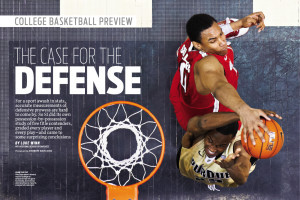College Basketball Handicapping – Top Defensive Teams
A look at College Basketball’s Defensive Dominators and Top Defensive Teams
It’s been nearly 30 years since the advent of the three-pointer and the shot clock changed the face of college basketball. The three-point shot has allowed teams to overcome larger deficits and created tremendous excitement for the game. However, handicapping a team’s ability to make outside shots on a given night can become a bit frustrating at times with such variance. That was the case with us last week when we played on No. 5-ranked Xavier two times. The Musketeers hit just 1/21 shots beyond the arc in their worst performance of the season losing at Creighton 70-56. But we were back on the Big East boys at Butler Saturday when they improved to 22-3 with a convincing 74-57 road ‘Dog win hitting 57% FG including 9-of-18 from the 3-point line.
In addition, the new rules changes and reduction in shot clock to 30 seconds have sped up the game, allowing more freedom of movement and benefitting the more athletic teams.
Still, the basic principles and fundamental focus remains of great importance in basketball. On offense the team must value the ball with a positive assist to turnover ratio. Good shot selection remains an absolute must if a team wants to experience success. The concepts of boxing out and rebounding are key to increasing the number of possessions, as is the percentage of loose balls and steals a team can create. Converting a high percentage of foul shots is important, especially late in games.
 Yet when determining a team’s success in college basketball there can be little dispute that the opponent’s field goal percentage is of key importance. Field goal percentage defense is more important than points allowed because an opponent’s points can be determined to a degree by the number of possessions they have which in turn can be influenced by an offensive pace that creates lower overall possessions in a game.
Yet when determining a team’s success in college basketball there can be little dispute that the opponent’s field goal percentage is of key importance. Field goal percentage defense is more important than points allowed because an opponent’s points can be determined to a degree by the number of possessions they have which in turn can be influenced by an offensive pace that creates lower overall possessions in a game.
As a result a team’s overall defensive field goal percentage and three-point field goal percentage defense remain key indicators when judging a team’s defensive ability. These must work in tandem to be efficient since a team can pack the paint defensively to minimize higher percentage two-point shots while sacrificing defense outside the arc. Conversely, too much attention to perimeter defense can sacrifice a team’s ability to defend the paint. When a team combines solid defensive play with rebounding strength and the ability to block or alter shots, you have a team that is capable of competing most any night against any team.
Yet, while strong defensive play is often key to winning more basketball games, a team must also take care of the basketball, minimize turnovers, take good shots and control the boards. Thus, I’ve included a link to reference stronger teams in rebounding rate.
With these concepts in mind it’s up to the handicapper and sports bettor to determine a team’s motivation level, how they match-up with each opponent and how these statistics can be used and adjusted throughout the season based on quality of opponent faced. Some teams play softer schedules and opponents in the early part of the season while also adjusting to new players, coaches and systems. I like to focus on “conference only” statistics as a more accurate barometer of a team’s overall strength.
The stats below are season-long numbers and it’s up to you to dig deeper into a team’s stat profile and recognize opponents faced, home/road splits, player injury impact, motivational factors and other scheduling and situations while also recognizing the importance of quality coaching.
Through February 14, 2012 here are the top defensive teams that are allowing 41% or less field goal percentage defense and 34% or less shooting from behind the arc and 68 points or less per game. I’ve also noted how these defensive dominators do in rebounding the basketball and provided their Adjusted Defensive Ranking from KenPom (350 teams).
Also, some teams not on the list are clearly solid defensive teams with positive coaching profiles. Such is the case with Oklahoma, who has solid defensive numbers and overall defensive efficiency rank of No. 33, but allow 70 points per game while playing at a faster pace and scoring 84 PPG.
Teams not on the list who just missed qualifying in various categories but rank top-50 in adjusted defensive efficiency include:
Alabama, Arizona, Cal, Cincinnati, Kansas, Kansas State, Miami, FL, Oklahoma, Texas. Virginia, West Virginia, Xavier
I hope you can use some of this as a guide when handicapping the rest of the college basketball season along with the college conference tournaments (CCT’s), NCAA Tournament, NIT, CBI and even the new Vegas 16 post season tournament. Also utilize and reference this list for early season play next year when factoring in returning starters, coaching philosophy and a team’s defensive strength in a system.
Note the stats below are from games against Division 1 opponents only.
PPG – Points Per Game Defense
| College Basketball Top Defenses as of February 15, 2016 | |||||||||||||||||||||||||||||||||||||||||||||||||||||||||||||||||||||||||||||||||||||||||||||||||||||||||||||||||||
|
If you don’t have the time, energy or ability to research stats, situations, schedules and systems that are proven profit producers, then get on my bag and join me as we fire for more profit and green. Handicapping college basketball has many factors and dynamics in late season play with second meets, last home games, college conference tournaments and other motivational and profit producing profiles that many bettors and handicappers don’t understand. Join a proven pro that has a great feel for the game along with the experience and understanding of the many situations, stats and systems involved in successful point spread prognosis.

 Twitter
Twitter Facebook
Facebook